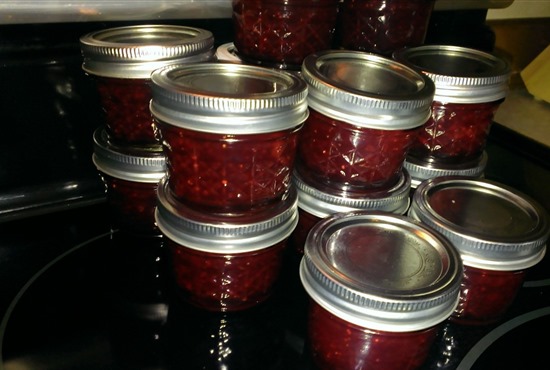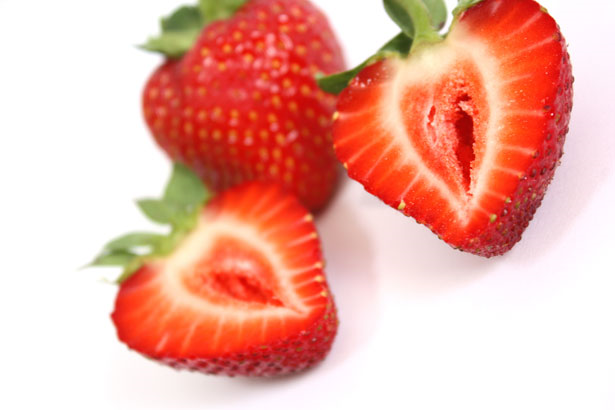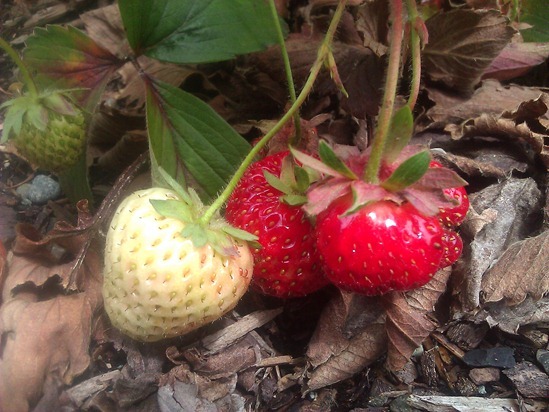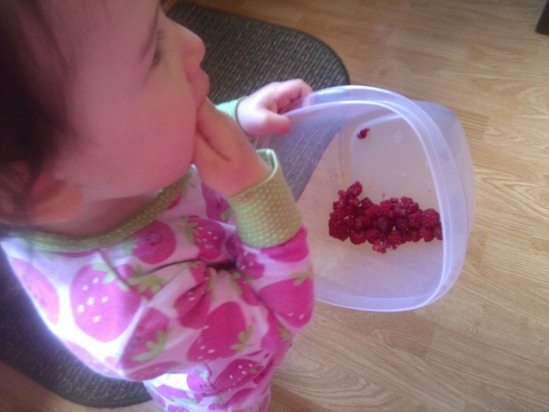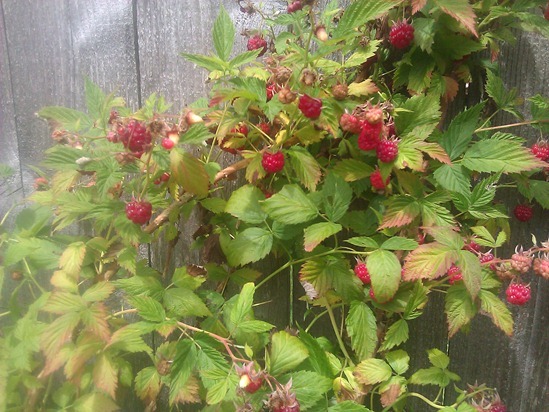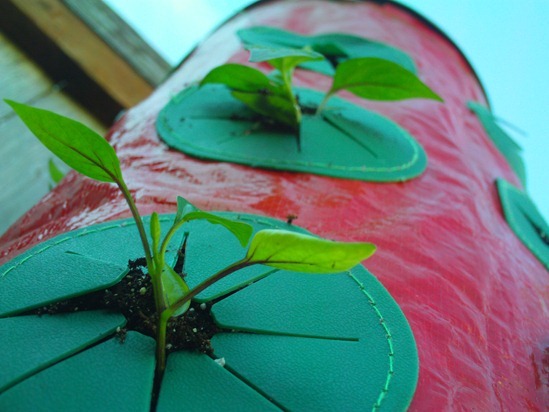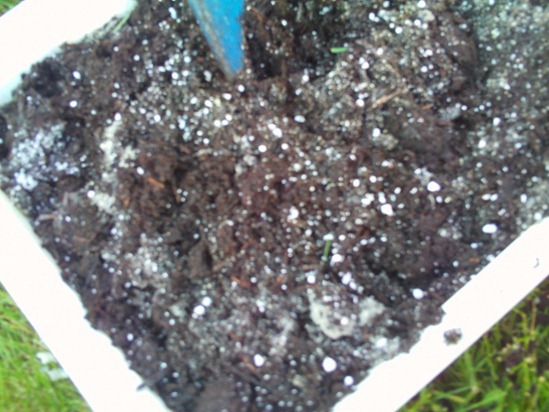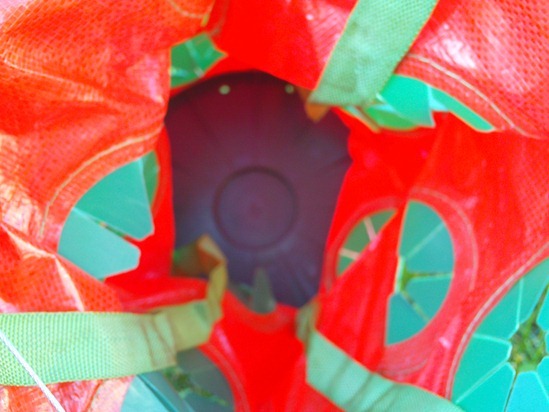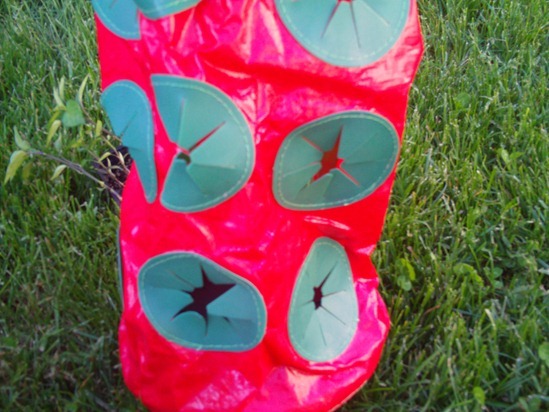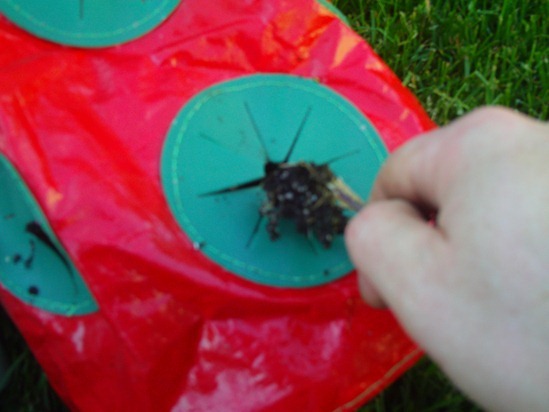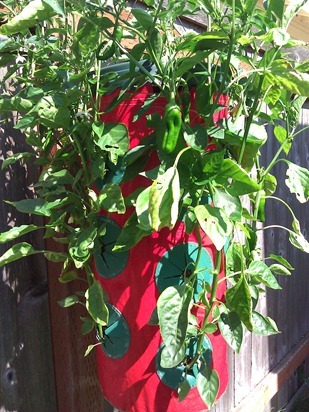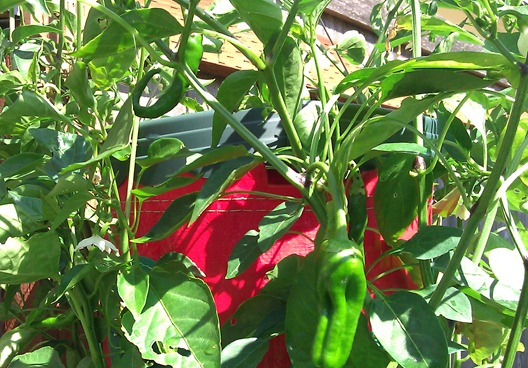How to make strawberries last longer
10.9 years ago perserve, puree, recipe, strawberries
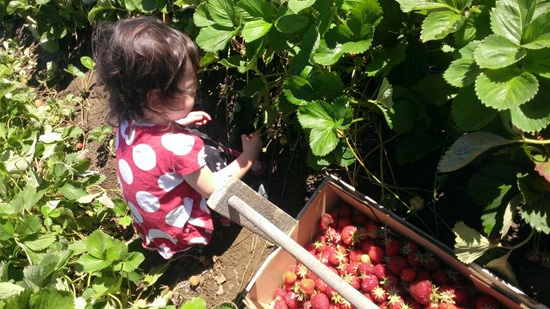
My youngest (2 years old) decided to venture out and too a little strawberry picking this weekend. It took her a little while (probably a solid pound of berries) to figure out we were supposed to be picking berries and putting them into our flat and not her mouth. Thirty minutes later and $11.50 paid I left with my full flat (11.5 pounds of berries)
The great about thing picking fresh strawberries is they are ripe and delicious, but the bad thing is you only have a few days before they start to go bad. Knowing that my little strawberry monster (and her older sister) would not even be able to get through over 11 pounds of berries in 3-4 days so had to start considering preservation methods.
Prevent the strawberries from molding
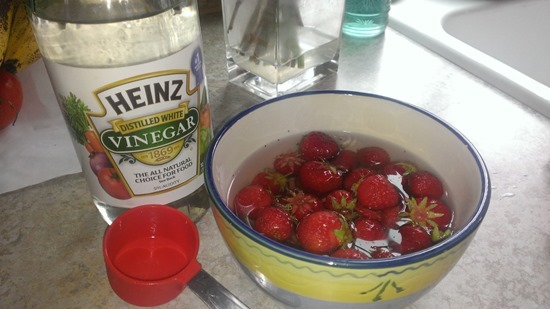
Here is an easy technique to extend the life of your berries by a few days to even a week. Prepare a solution of 1 part vinegar to 10 parts water (example for pint of berries I prepared above I did 1/8 cup of vinegar and 1.25 cups of water) Add your strawberries and given them a quick spin. Next you can optionally rinse them (solution is pretty weak so I do not taste any vinegar taste if I don’t rinse) and then place on an open air container.
This technique also works for other berries that may have molding problems and can enable your berries to last about a week or even up to 2 weeks depending on the actual ripeness when they were picked.
Sugar coat them
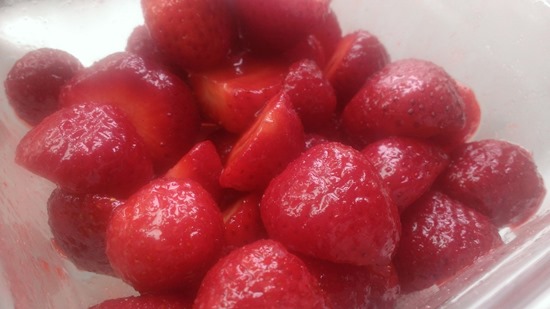
Though fresh organic strawberries are sweet enough all by themselves but adding about a teaspoon of sugar to a pint of cut strawberries will generate some strawberry syrups which can easily give you a week in the fridge. This can be a great topping to ice cream, pound cake, angel food cake, or even by themselves topped with a little whipping cream.
Strawberry Jam
This was the first obvious method of saving some of these delicious berries for next year. I picked up some new 1/2 cup jars since we typically do not make it through a full cup jar once the 3 week timer starts after cracking the seal. Also great size for sharing with the neighbors.
The recipe for any type of jam can be found in your box of pectin but I will repeat it here since I personalized some techniques to speed up the process.
Ingredients
- 5 cups of strawberries (4 cups crushed)
- 7 cups white sugar
- 1 package of pectin (I personally prefer the liquid form)
Directions
- Wash and cut tops off berries and crush them. I personally add them to my food processor and given them a little pulse to chop them up. Be sure not to over do this you want some chunks in there not a smooth puree.
- Add berries to large pot or saucepan and heat at medium high and add sugar.
- Let berries and sugar come to a rolling boil (when you still bubbles continue)
- Add pectin and wait until rolling boil returns and let boil for 1 minute while constantly stirring
- Remove from heat and fill cleaned a boiled jars/lids with 1/8 inch gap at the top being careful to remove any jam on the top of the jar.
- Once all jars are filled add to large pot filled with water on rolling boil (be sure to account for the displacement that will occur when you add your jars) The directions say you should have 2-3 inches of water over your jars. My tallest pot doesn’t allow this even for these 1/2 cup jars but have gotten good seals with 1/2-1 inch of water above in the past.
- Let boil for 10 minutes (more if higher altitude but see directions on pectin) and let sit at room temperature. Check the button on the top to see if you have a good seal. If one doesn’t stay down, no worries just through it in the refrigerator and that will be the first jar you consume. Let the remaining sit a room temperature for 24 hours, checking the seal again.
Your jam should be good for up to a year with a solid seal and up to three week refrigerated after opening.
Freezing Strawberries
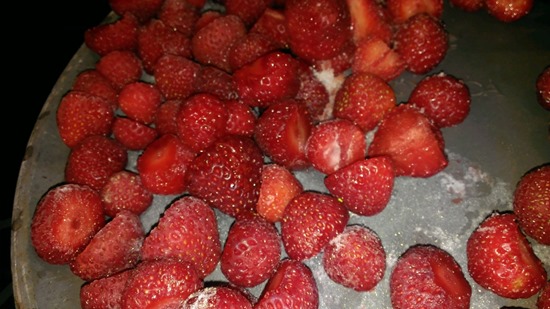
Freezing strawberries is a very easy option for preserving your produce. What I do is wash the berries and remove the tops and split any berries that are significantly larger than the others. Place on a cookie sheet and freeze for 8-12 hours and transfer to freezer bags and remove air with a straw (poor mans vacuum sealer) or use real vacuum sealer like I did below. With this technique the berries should not stick together and all ready to make some shortcake next winter.
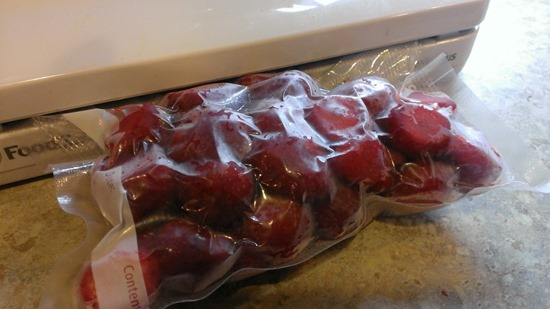
Growing Fruits in Small Spaces
11 years ago blackberries, fruit, guest post, raspberries, strawberries
Are you planning a garden this year? If so, you are in good company. Over 50 million American households will be growing some or all of their own fruits, vegetables, herbs, or berries. Plant nurseries, garden centers, farm supply and home improvement centers have all noticed an uptick on sales of seeds, plants, seedlings, Fruit Plants, fertilizers and gardening tools this month.
So many people have taken an interest in gardening that even people who live in apartments, condos and houses with small yards can satisfy their urge for a green thumb. You do not need large plots of land to be a gardener. Patios, balconies and tiny back yards can be decorated with flowers, herbs, vegetables and fruits – thanks to container gardening and new types or varieties of plants. Community gardens are another way to find the space needed to grow your own fruit and vegetables.
Benefits of growing your own produce include:
- improved quality,
- better taste,
- guaranteed freshness,
- bigger variety of choices,
- control over the use of pesticides and chemicals, and
- average cost savings of about $500 per year!
If you have the urge to try your hand at growing your own produce, consider starting out with some inexpensive container plants. Everyone has seen the TV commercials for kits that hang from the roof or a shepherd’s hook to produce fresh strawberries and cherry tomatoes. But container gardening can go much farther than that.
Suburban and urban households – even many retirement village and nursing home residents – can join in the fun of watching fruit plants and vegetables grow, and then harvest them at home. You can buy seed packets or young seedlings that were started commercially for harvesting in late summer and early fall, or try for years of production and harvesting by planting dwarf fruit trees.
Small spaces can use:
- Window boxes
- Trellises
- Hanging baskets
- Raised beds in a variety of sizes and shapes, and
- Thousands of types and sizes of pots
to help grow a variety of fruits and vegetables on patios, balconies and in small yards.
Fruit trees designated as appropriate for your growing region will be disease resistant and tolerant of the climate in your area. Citrus trees do well in Florida, along the Gulf Coast and throughout California. Blueberries and cherries do well along the East Coast and mild climate zones. Apples come in dozens of varieties. Both apple trees and pear trees can be found in every state of the continental U.S. For container gardening, there are dwarf versions of dozens of types of fruit trees.
To start your successful container gardening, community garden or home vegetable garden project, find good internet resources to research want you hope to grow, and talk to local nurseries and orchards about the types of plants and trees that will work for your climate and site. There are many decisions to make early, including:
- preparation of area: tilling, testing and adjusting the pH balance, and spacing
- type of fruits and vegetables: bush plants versus pole or trailing plants
- variety/rootstock combination: dwarf trees, hybrids, grafted twigs, crossbreeds, etc.
- recommended planting techniques and timing,
- pruning, thinning, training,
- nutrition
- disease and pest control
Check back later this summer for pictures of my own container plants!
Picking strawberries and raspberries
11.8 years ago raspberries, strawberries
I like this time of year when I can quit my second job to support my kids strawberry and raspberry habits. At $5-6 for a half pint at some times throughout the year can be a great cost savings to pick these for practically free year after year.
My oldest was previously the biggest consumer but now out youngest (now 16 months) is taking in her share of the berries and has been enjoying the fresh local berries. We actually can not go anywhere without providing her with her strawberry fix. Not sure what we will do in a couple months when we stop producing.
For my area still is a little early for raspberries but the conditions have been working out and have been enjoying these for the past couple weeks as well. I did not actually plant these raspberries they snuck in under my neighbors fence which a little precautionary raspberry control I have let them thrive on my side of the fence as well. I am actually considering to let them spread farther down my fence for even larger yields.
Growing peppers in a Topsy Turvy strawberry planter
13 years ago cayenne, jalapeno, peppers, strawberries, upside down planter
I made a little discovery last year and that is that peppers really don’t need a lot of room to grow, require soil a little warmer than it normally gets around here, and do not mind getting a little dry between watering. This seems like great characteristics to grow peppers in vertical containers. With this in mind at the end of last year I picked up a couple of Topsy Turvey Strawberry Planters at over 50% off when the season was well over. Topsy Turvey does make hanging pepper plant containers but I chose the strawberry planters instead for two main reasons; first they normally sell for a few dollars cheaper. Second, they are much larger and make better use of more vertical space and I can plant at least 18 pepper plants in each one.
For my mix I started with your typical soil mix and then amended it with perlite at a ratio of 3 parts potting soil and 1 part perlite. I also added a cup of bone meal to since it much easier to add now then in a couple months when they really will need it.
As you can see from this shot there is plenty of room for these peppers to spread out and should have enough root space for some decent yields
I then filled up the hanging container until it was filled up to the bottom most hole.
Next I carefully placed my pepper plants into the wholes than reached in from the inside and provided just a little bit of pressure to pack the soil enough to keep the plant secure in place. I repeated this process for the 11 other pepper plants I had ready to plant.
Finally my assistant and I poured in about a liter of water (soil was already a bit wet putting it in) and admired our work. With some strange bit of crazy luck we actually started having some great weather after we planted these and hung them up. So you can thank me Pacific Northwest…
As you can also see from the picture above I still have 6 more holes to add some more pepper plants which I have plenty in my grow box which I am allowing to mature a little longer. I will plan on providing updates on this post as highlights with this experiment develop.
RESULTS
After a cold summer weather we finally have had a good month of good weather with what appears to be at least another week of sunshine coming. This has been great for the peppers in the strawberry planter.
In this planter I have 18 pepper plants, even with the cold spring/summer they all survived and are now thriving on the top part of the plant I have hot peppers (cayenne) and on the lower half I have sweet peppers. All that was required on maintenance was watering every few days where I also rotated about a quarter turn to get even sunlight on all of the plants.
As these pepper on the plants ripen more I plan on making some cayenne pepper and some paprika (possible some smoked paprika as well) from the sweet peppers. Overall I have been very impressed with the results of this little experiment and plant to grow more peppers using this method next year.
Most profitable fruits to grow in your home garden
13.1 years ago blackberries, peach, raspberries, strawberries, summer
I previously did some analysis on the profitability of vegetables in your garden and there have been requests as well as my own curiosity of how fruits would stack up against fruit trees/bushes.
To keep things simple I made the assumption of fruit trees/bushes are fully mature with maximum yields. So please take into account that you will see some variance throughout the years. I have also used the fair market retail value of fruit when purchased by the pound, obviously all of these could be purchased cheaper by the bushel…but many of us you live in urban areas it can be difficult to make these discounted large purchases nor consume 48 lbs. of apples before they go bad.
After a crunched the numbers I was a bit surprised and happy to see blueberries at the top of the list. I have four blueberry plants already in the ground and two more waiting to be planted. Though one asterisk for this plant is that is take 3-4 years to really start producing but you get several years of good production and by buying a variety of plants with different harvest times, so unlike many other fruits you do not get a huge supply of fruit all at the same time.
Overall fruit compared to vegetables provides a similar range of harvest value depending on the variety. There are a couple of differences that should be taken in to consideration:
- Space: Fruit trees/plants range from a little over a square foot to over 60 square feet per planting
- Time to Maturity: It can take several years for some trees to become mature and start producing high yields.
- Size of Harvest: You could see hundreds of lbs. of produce within a couple weeks. You will need to determine a means to actually use this (canning, pies, forcing on neighbors)
- Commitment: Unlike annual vegetables if you decide you really don’t care for the produce it can be time intensive and expensive to switch out an apple tree for a difference variety.
| Fruit | Harvest Value/ Square Foot |
| Blueberries | $ 18.71 |
| Pomegranate | $ 13.38 |
| Nectarine | $ 8.64 |
| Strawberries | $ 8.13 |
| Peach | $ 7.90 |
| Apple (Standard) | $ 6.64 |
| Apple (Semi-Dwarf) | $ 6.40 |
| Raspberries | $ 6.23 |
| Apricot | $ 3.54 |
| Plum | $ 3.18 |
| Blackberries | $ 3.05 |
| Pear (Standard) | $ 2.90 |
| Fig | $ 2.66 |
| Almond | $ 2.56 |
| Apple (Dwarf) | $ 2.35 |
| Walnut | $ 2.28 |
| Pear (Dwarf) | $ 2.10 |
| Cherry (Sour) | $ 1.13 |
| Cherry (Sweet) | $ 0.84 |
As always the common sense principles apply:
- Grow what you like to eat
- Cost is only one factor to consider, you can’t beat real fresh produce
Strawberry picking Robots
13.4 years ago robot, strawberries
Well this is not the first time we have seen robots harvesting food and probably not the last but a team in Japan has created a robot that selectively picks strawberries that are at least 80% red. Though this might be good enough for the average consumer at the grocery store, I would personally insist on closer to 95% and hold off until they are a slightly darker red for some extra delicious super ripe berries.
They estimate that this robot can reduce picking time by by 40% but at 9 seconds a berry I am pretty sure I can easily keep up with this monster…though I eventually have to sleep and eat so the numbers may work out. I also would have to make the assumption that this is being targeted for growing hydroponic strawberries given even with my primitive human vision I need to move some leaves around to see most of the berries I pick in my back yard.
There is no word on the cost of this strawberry picking robot but you can check out a video of this bad boy in action below.
Tags: strawberry, strawberry plants
